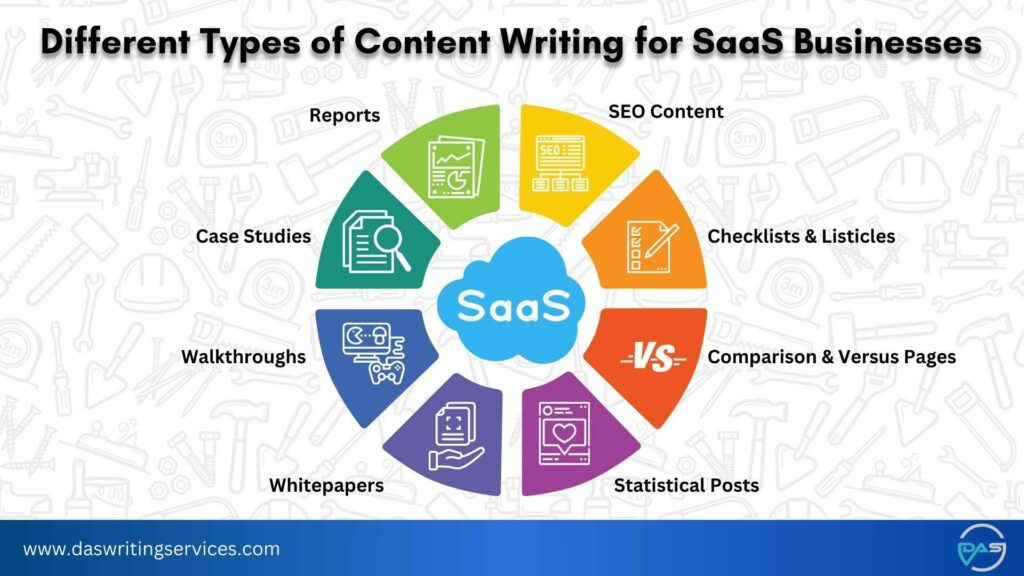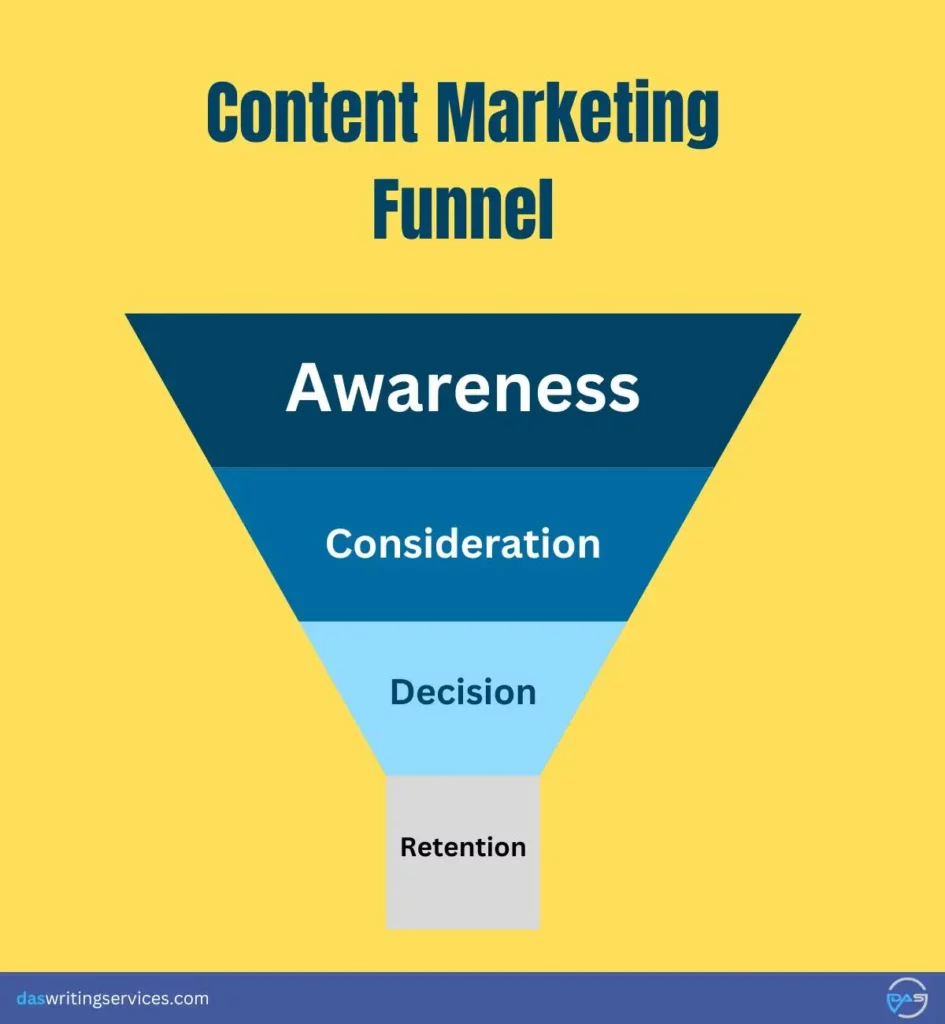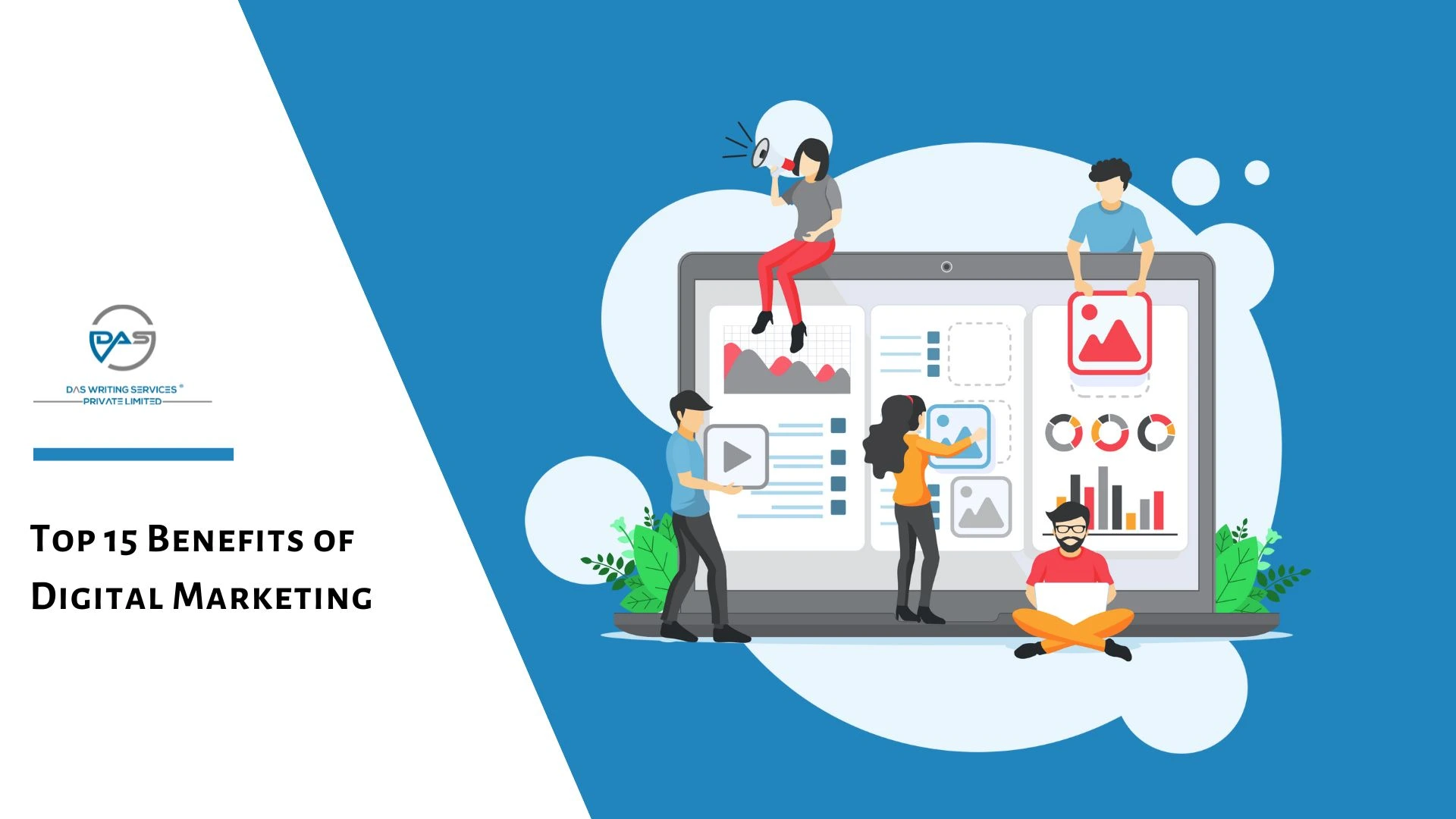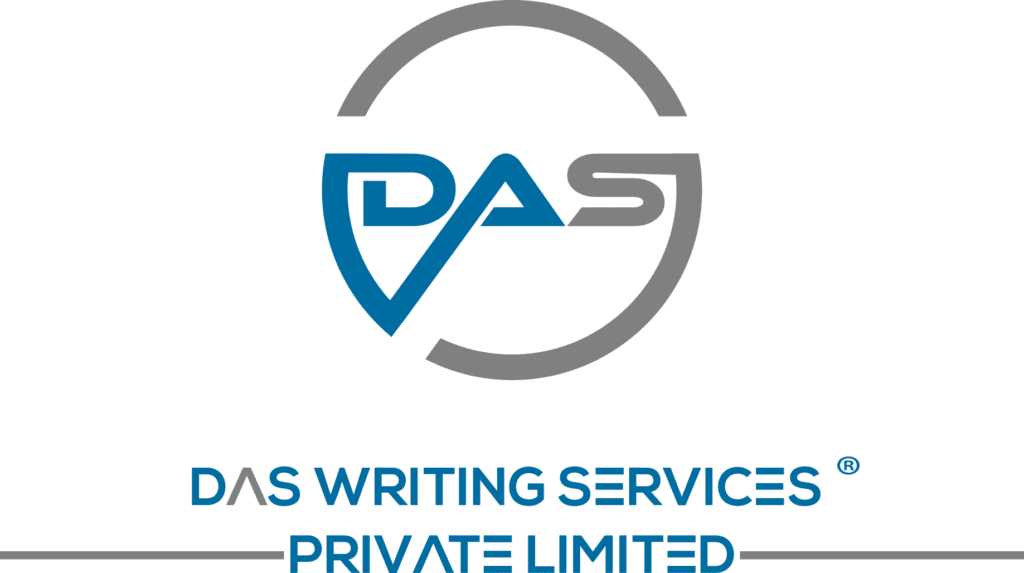Content writing has emerged as a vital force for SaaS companies, and it’s easy to see the reason.
From engaging blogs to insightful, data-driven reports, investing in skilled SaaS content writers can be one of the smartest decisions for your brand. Their work not only educates and informs readers but also motivates them to take crucial actions, such as signing up for your product.
However, producing outstanding SaaS content is a nuanced skill. It requires a thorough understanding of your target audience, a clear grasp of your product’s unique value, and expertise in the intricacies of content marketing within the SaaS industry.
In this guide, we will delve into all aspects of SaaS content writing. We’ll cover what it entails, the different tactics writers employ, and how to select a SaaS content writing agency to create top-notch content.
What is SaaS Content Writing?
SaaS content writing involves communicating, educating, and showcasing how your target audience can leverage your product to address their challenges.
It emphasises how your product simplifies their lives and why they should choose your solution over competitors. It helps SaaS companies enhance brand visibility on search engines, boost conversion rates, and drive revenue growth.
The primary objectives of SaaS content are to:
- Make potential customers aware of your SaaS offering and attract them
- Educate them about the product’s purpose and its value
- Encourage them to become your customers
While many SaaS organisations produce their content internally, outsourcing content writing can significantly benefit teams with limited resources.
By leveraging the expertise of content writers or agencies, brands can create engaging, and search-engine-optimised (SEO) content that captivates audiences, enhances brand visibility, generates leads, and boosts sales.
Looking for content? Get professional help at your fingertips!
SaaS Content Writing vs Other Forms of Content Writing
SaaS content writing stands apart from other types of content creation in several ways. While general content writing may cover a wide range of topics, SaaS content is specifically designed to explain how a customer can use a SaaS product to meet their requirements. Here are some key distinctions:
Target Audience
SaaS content writing is aimed at users seeking software solutions, typically focusing on B2B (business-to-business) or B2C (business-to-consumer) customers with specific requirements. In contrast, other forms of content writing may cater to a more diverse audience with varied interests.
Technical Complexity
SaaS content writing often involves intricate technical details. Writers need to clarify complex software functions in a way that is easy to understand. Other types of content may not demand the same depth of technical knowledge.
Goals
SaaS content aims to convert readers into users or customers by showcasing the product’s features, benefits, and practical applications. Compared to other types of content writing, product adoption is the foremost concern for SaaS content writing.
Focus on Education
SaaS content frequently includes instructional materials such as guides and how-to articles. The educational aspect is more prominent than in other content genres.
Product-Centric Approach
SaaS content writing centres around a specific product or service. In contrast, other forms of content may explore broader themes without directly linking to a particular product or service.
Benefits of SaaS Content Writing
Content writing gives you control over your brand voice and influences public opinion of the brand. The following are some of the benefits it gives:
1. Building Credibility and Thought Leadership
SaaS content writing delivers insights and resources that address the specific challenges faced by your target audience. By doing so, you foster trust among your audience and position your SaaS company as a leader in your industry. Effective SaaS content showcases your expertise, allowing your company to be recognised as a reliable authority in its field. As you may be aware, there is a strong link between high domain authority and improved SEO performance, which can be a significant asset in a competitive market.
2. Knowledge Creation and Brand Awareness
B2B and B2C SaaS content writing allow you to create and command knowledge about your brand as well as the products you are offering in the market. For most SaaS businesses, confusion about the product in the market becomes a major roadblock. Consistently creating knowledge in the form of blogs, guides and webinars helps you reduce the knowledge gap and familiarise people with the product.
3. Organic Visibility
Effective SEO optimization allow you to increase your visibility on the SERP and get more people to find your naturally. With the right set of keywords, creating SaaS blog allow you to be more visible to the right audience. Coupled with strategic social media content, your brand will naturally appear to the audience.
4. Humanizing Your Brand
SaaS businesses often operate in a technical landscape, but effective SaaS content allows you to infuse a personal touch into your brand, making it more relatable to your audience.
In other words, you can use your content to engage with your target audience in a friendly, conversational manner, as if you were having an in-person discussion.
5. Fostering Engagement
SaaS content can effectively engage your target audience in multiple ways.
For instance, it enables you to connect with your audience at a personal level, educate them about their challenges, and provide real-life examples of how your product addresses those issues.
To enhance interaction, incorporate engaging elements such as polls, quizzes, surveys, and clear calls to action throughout your SaaS content.
By consistently producing fresh and relevant SaaS content that informs and invites participation, you can boost engagement with your audience and generate conversions.
Step-by-Step Guide to SaaS Content Writing
High-quality SaaS content writing is not a matter of luck. Writers employ a range of SaaS content writing strategies to connect effectively with their audiences and support product sales. Here are the key steps for effective SaaS content writing:
1. Define Your Business Objectives
Before creating SaaS content, it’s essential for every SaaS company to clearly define its business objectives.
This initial step is crucial because having well-defined goals allows companies to align their content strategies with the key performance indicators (KPIs) that are most important.
2. Research The Target Audience
Before you begin writing, it’s crucial to have a clear understanding of your target audience. Your content must align with the needs, challenges, and language of your ideal customers.
To truly know your audience, it’s essential to conduct comprehensive research into their demographics, challenges, and objectives. This helps create tailored content that addresses specific customer issues and delivers valuable, relevant information.
3. Know Your Product
Product knowledge is crucial for B2B SaaS content writers. As SaaS is a complex domain, SaaS writers must know the ins and outs of the product. It helps to curate content incorporating product details for the target audience to understand.
4. Focus on Empowering The Audience
Empowering the audience with your content is an integral factor that helps improve the content quality. You can adopt two approaches to curating SaaS content; one is the problem-solving approach while the other is the educational approach.
The former includes problems and solutions that your target audience can get from the use of the software. On the other hand, the latter includes providing additional information to the target audience to educate them and enhance their awareness.
5. Evaluate Your Current Content
In the realm of SaaS content writing, simply creating new material isn’t always the solution.
This is particularly relevant if you’ve been producing content for some time without achieving the required results.
In such cases, conducting a content audit should be your primary focus.
A content audit allows you to evaluate the quality of your existing content and analyze its performance over time, helping you identify what resonates with your audience and what falls flat.
Additionally, search engines like Google favour websites that consistently refresh their content with up-to-date information. Regularly auditing your content will provide valuable insights into which types of SaaS content are currently effective and which practices may no longer be relevant.
6. Identify High-Value Keywords
After reviewing and refreshing your existing content with updated information, it’s time to strategise for new SaaS content creation.
Before diving into the writing process, it’s essential to determine what your target audience is actively searching for and focus on high-value keywords. If you fail to produce content that aligns with your audience’s interests and queries, your efforts may not yield the desired results.
7. Decide Which Part of the Marketing Funnel You Are Targetting
The content marketing funnel describes the journey of your target audience towards becoming a customer. Top-of-the-funnel content is meant to make people aware of your services whereas the middle and the bottom sections are meant to take people towards sales generation.
You need to decide which section of the funnel you are targeting and prepare your content accordingly.
8. Understand and Satisfy the Search Intent
Creating effective SaaS content goes beyond simply identifying the keywords your target audience uses; it’s crucial to comprehend the search intent associated with each keyword.
Understanding this intent is vital as it reveals what users are truly seeking when they enter a specific keyword into search engines like Google.
Search intent can vary: it might involve looking for specific information (such as the best electrical gadgets), delving into a topic (like the benefits of meditation), or making a data-driven purchasing decision (for example, comparing iPhone prices on Amazon and Flipkart).To simplify this process, consider each keyword individually, put yourself in your audience’s position, and reflect on what they hope to find when searching for that term.
9. Create Content for Conversion
Curating content for conversion is essential to scale up your SaaS business. You can include call-to-action or CTA in your SaaS content to boost conversion from your curated content. In addition, you can use internal links to other pages of your SaaS website to navigate traffic.
Navigating traffic to service pages of your website can be significant in increasing the conversion rate. The ultimate purpose of your content is conversion; as a result, you need to incorporate factors in your content that foster conversion for business growth.
10. Focus on Content Quality
High-quality content is essential to influence the target audience and drive sales conversion. You need to focus on improving the quality of your content by analysing the competitors. Ensure you incorporate information that is unique and different from your competitors to stand out as an industry player.
In addition, you need to optimise your content through an effective plan to improve its quality. You can curate high-quality content by incorporating and highlighting distinguishing product features thereby reaching out to the target audience with helpful and unique content. This helps cater to the needs of the target audience as they often look for high-quality content before making informed purchase decisions.
Types of SaaS Content Writing

Since majority of SaaS companies offer B2B solutions, the major challenge of SaaS content creation is to cater to the interests of the target businesses. What works for B2C or D2C brands may not be the best strategy when it comes SaaS content writing for B2B. Here are some of the tried and tested types of content writing that a SaaS writer can help you produce.
1. SEO Content
While SEO blogs may feel like the default strategy, thorough market research must be performed before finalizing on a content plan. Selecting on the right keywords that is relevant for your target group is crucial to make this work.
2. Checklists & Listicles
This one is a safe bet. When you cannot zero in on any topics, craft content around the buzz in the market. You can create checklists and listicles to inform your top of the funnel SaaS audience on latest trends or simply enumerate the benefits you bring to the table.
3. Comparison & Versus Pages
Again, these content formats prove highly efficient to target new demographics with your content marketing strategy. Comparative analyses between your services and the market standard makes a great opportunity to showcase your value propositions at the very beginning.
4. Statistical Posts
The primary goal of SaaS content writing is to target the leadership and decision-makers decision-makers in a business. Web and LinkedIn posts that highlight the statistical advantages of your services with the right figures can really hit the right spot with your audience.
5. Reports
Hiring content writer for SaaS gives you access to expert writers in the industry. You can leverage it to produce regular reports both for stakeholders as well as for newsletter subscribers. Just make sure that your content strategies bring some value to the table to create impact.
6. Case Studies
With case studies you can build a powerful SaaS brand that your target group will come to regard as authoritative. For completely new brands, you can start with general business case studies to highlight your analytical and critical insights. Or as popular SaaS players, you may produce case studies of how your products have come to aid businesses.
7. Walkthroughs
For a new brand, SaaS content strategy is vital to create the first impression spot on. Long-form content writing for SaaS allow you to create knowledge about the user experience of your product – making it more familiar for the audience.
8. Whitepapers
Writing SaaS content is not only about new client acquisition. The primary motive is always to create information and emphasise your unique approach to tackling the problems of the industry. As a piece of content whitepaper can instil trust and transparency between audience and the company.
5 Common Mistakes to Avoid
When you choose content as your guiding strategy, ensure that you are doing it right by avoiding the following mistakes:
1. Not Defining the KPIs
Producing content aimlessly is as good as producing nothing. At the very onset, define the metrics to judge the effectiveness of your campaign. 6 months are usually enough to know if it is working or not. Set the timer and decide on metrics like organic clicks, enquiries, increase in ranking keywords and so on.
2. Top of the Funnel Only Content

To get the desired outcome with content, it is recommended to create content for each stage of the buyer journey. Many businesses make this mistake by producing content only for new audiences without chalking out a clear roadmap for them.
Aside from blog posts and whitepapers, create newsletters, walkthroughs, case studies along with attractive landing pages to nudge your audience towards the right direction for conversion.
3. Generic Target Group Optimization
Just because a keyword has a high search volume does not mean it is the one you must target. Spend time identifying your target group based on the product. Create buyer personas and curate your SaaS content strategies around it for multiple platforms.
4. Lack of Diverse Content Distribution
To thrive in the SaaS market, it is vital to write SaaS content for different marketing channels like websites and social media platforms. While blogs are good for the web and organic search, infographics, social media posts, YouTube videos, webinars, and podcasts give you the flexibility to reach audience through different platforms to get the most out of your marketing campaign.
5. Fully Outsourcing Content Creation to Freelancers
One common mistake for SaaS companies is completely outsourcing their content creation to freelance writers. While hiring freelancers can be a cost-effective solution, it often leads to a lack of thorough research and diminished quality. When companies delegate all content responsibilities, freelancers may select topics based on their own interpretations rather than incorporating the company’s unique insights and perspectives.
To produce outstanding SaaS content, it’s essential to include ideas that reflect a deep understanding of your product’s features, unique selling propositions (USPs), and competitive landscape.
Thus, although engaging freelance writers can be beneficial, it’s crucial to communicate your company’s expertise and the unique aspects of your product. This ensures that the content they create is both relevant and stands out in the marketplace.
Bid adieu to all worries with our professional content writers
How to Choose a SaaS Blog Writing Company?
Collaborating with a specialised SaaS blog writing agency can significantly enhance your content marketing strategy.
However, how to decide which company will serve you the best? When evaluating potential partners, it’s important to concentrate on the following key factors:
Relevant Industry Experience and Knowledge
Seek out a company that has demonstrated success in producing content specifically for the SaaS sector, especially in the formats you wish to create, such as blogs, landing pages, or newsletters.
They should be familiar with the unique challenges, terminology, and best practices associated with SaaS content writing, understanding that this niche requires a tailored approach and perspective.
Having someone with established experience in your specific industry can add significant value. It’s even better if they have collaborated with well-known brands or produced content that you respect and admire.
SEO and Content Marketing Approach
Search engine optimisation (SEO) and content creation are closely interconnected. A reputable SaaS blog writing agency should possess a strong understanding of SEO best practices and effective content marketing strategies to maximize the visibility of your content to potential customers.
Inquire about their SEO methodology and how they integrate it into their SaaS content writing process. The agency you select should be capable of producing engaging content that not only resonates with your audience but also enhances your search engine rankings, ultimately contributing to measurable business outcomes.
Content Management and Workflow
Inquire about the company’s processes for managing content and their overall workflow. Having a well-organised system for content creation, publishing, and auditing can lead to a more consistent and efficient production process.
Reporting and Analytics
Adopting a data-driven strategy is essential for evaluating the effectiveness of your content initiatives.
Select a SaaS blog writing agency that offers comprehensive reporting and analytics, either through its own tools or the software you prefer. These insights will enable you to monitor the performance of your content and make better choices for your future strategies.
Communication and Collaboration
Strong communication and collaboration are vital for a fruitful content partnership.
Inquire about the company’s preferred communication channels. Which platforms do they utilise to interact with clients? Determine who your main point of contact will be and how frequently you can expect to connect with them.
Evaluate their responsiveness and openness to working closely with your team. This will help ensure alignment with your content objectives.
SaaS content writing plays a vital role in shaping effective content marketing. Skilled SaaS content writers leverage their understanding of the product, marketing insights, and SEO knowledge to craft engaging content that reaches the intended audience. They must strike a balance between delivering valuable information and highlighting the USPs of the SaaS product.
Collaborating with a SaaS blog writing agency is an excellent option for outsourcing your content creation to a team of experienced professionals. They can help you refine your brand voice, produce impactful content, and align your efforts with your business goals.

Ritish Dutta is a seasoned Content Developer with over 7 years of experience in the industry. Currently, at Das Writing Services, he writes SEO-optimized content that caters to our diverse clientele. Ritish utilizes his critical insights and experience to talk about digital marketing, SEO content writing, content strategy, and AI.






Leave a comment
All comments
Arghish Das
This is a really helpful article! I especially like the part about creating different types of content. I'm wondering how you balance writing great content with making sure it shows up in search results. Sometimes it seems like you have to choose one or the other. Thanks for the great article!
Advika
Nice article! It was interesting to read.
Thanks,
Advika